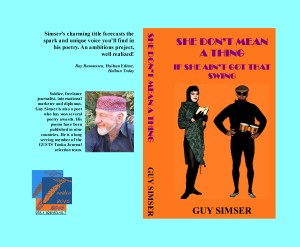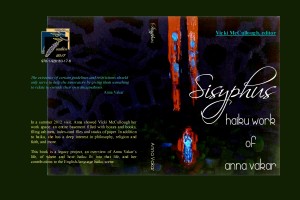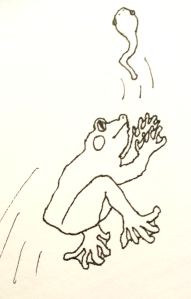Every morning I get help making coffee. Desirée is a rescue bird, a Green-Naped Rainbow Lorikeet with whom I’ve shared my home for nearly nineteen years. She is in charge of my daily routine, with her no-nonsense timing for meals and petting. But in May I had to leave her with my husband while I flew to Vancouver for our annual Haiku Canada Weekend, our conference and AGM.

You might conclude that we are a bit crazy. Perhaps. This is Pat Benedict Campbell and Vicki McCullough after their dramatic presentation, ‘A Dialogue about Haiku Reviewing’ written by Paul O. Williams. It was so much fun as well as full of information. Pat and Vicki nailed it.
First a shout out to Vicki McCullough and Lynne Jambor who organized this whole weekend plus, including University residences, food, our Western style banquet (My, that food was good!) the programme, before and after events, and so much more. You were always there for us. You are wonderful, both of you.

Vancouver is gorgeous in the spring. The gardens around The University of British Columbia brilliant with colour.
We stayed in residence which was no hardship at all. Here is a night view from my window.

But we really did meet there to work on haiku, which may seem like another reason to consider us a bit mad: three days and a good part of two nights given over to these tiny poems.

Our annual anthology, at the water’s edge, was presented on Friday evening, and introduced by one of its two editors, Devin Harrison of Coquitlam, BC. Mike Montreuil, the second editor was not able to attend. Then the Weekend race was on, with the AGM, presentations by Rich Schnell of Plattsburgh, NY, ‘Rockwell Kent, a Pacific Northwest Thoreau?’, the reading of Eartshine, by Chuck Brinkley, and another presentation by Chuck on ‘Re-re-rewrite’, one of the most illuminating and courageous presentations, as he showed how he worked on his own haiku through the years and suggested a list of ways to edit our poems. Nick Avis, of St. John’s, Nfld, explored haiku under the intriguing title of ‘Naked Haiku’, and whowould want to miss that. He discussed the cultural and literary contexts that are often layered in haiku.
Kathy Munro told us of her trip to The Frankfurt Book Fair, Jacquie Pierce introduced ‘Between Mountains: Haiku and Japanese-Canadian Internment Camps.’
Claude Rodrigue launched his Tanbun From Old Deer House (catkin press, 2019) which is introduced by Larry Kimmel who invented the form. Claude also enlightened us with a history of Haiku in Comic Strips. Michael Dylan Welch fascinated with the publishing history of Anne McKay, and GAVE us her beautiful last collection, the journey, passed on to us through Angela Naccarato from a dear friend of Anne’s.
Calgary’s Magpie Group, (Pat Benedict Campbell, June Read, Liz Gibbs, Meghan Elizabeth Jones, and Mary Vlooswyk) shared their work in a lively reading from their third anthology A Pebble in my Shoe, and Pat Benedict Campbell also launced her Alchemy of Tea (catkin press, 2019). My she has a way with presentation!
There was a unique experience in listening to ‘Women Echoing Women – A Haiku Enchamtment’, with Alegria Imperial, Josephine LeRo, Isabella Mori, Rachel Enomoto and Tracey Wan in which we heard haiku in several languages.
A ‘Town hall’ hour was with special guest, archivist Lara Wilson, Director of Special Collections, University of Victoria, where our haiku Canada Archives now reside, in which there was great audience participation as everyone is curious about how the archive works and how to contribute to it.
Angela Naccarato presented ‘Preschool Haiku’, and Edward Zuk followed with ‘Haiku and Surprise’, and we were impressed by this quiet poet’s energetic argument, and the poetryAngela has done with small children.
Bob Butkus displayed his Photo-Haiga, Julie Emerson talked about the ‘Haiku Gumball machine’ and Carol McRury read ‘How To Write a Haiku’ a piece written by Naomi Wakan.
Patrick Gallagher led us on a Raw NerVZ treasure hunt, a tribute to Dorothy Howard and her creation and editing of the journal. How grand to hear her editorial choices in the voices of poets at the conference.
Marshall Hryciuk and Karen Sohne again led the ‘not-too-late’ renku on Friday and Saturday nights, and performed the completed kasen on Sunday near the end of the Weekend.
After the revealing of the winners of the Sea to Sky sort-of-ginko, the Jocelyne Villeneuve Award and the Betty Drevniok Award, we almost said goodbye.
As you can see, anyone can see from this report how the business and fun of tiny poems can fill the days.
Of course, when it was over, it wasn’t really over. Haiku is never really over…so those who could stay longer went to the Dr. Sun Yat-Sen Classical Chinese Garden, with guide, Jacqie Pierce, and then afterwards we had a meal at a Chinese Restaurant.


I especially want to thank the volunteers who made the whole experience run smoothly, organizing the silent auction (over $700 raised!) and book tables, talking care of registration, sewing beautiful hand made notebooks, designing the graphics!!!! A million thank yous are on their way to you.
It took a few days to wind down from this time with some of our favourite members of our Haiku Canada family. And so, on to my next gallivant to the opposite side of Canada, St. John’s, Newfoundland, where The League of Canadian Poets held its AGM and conference.
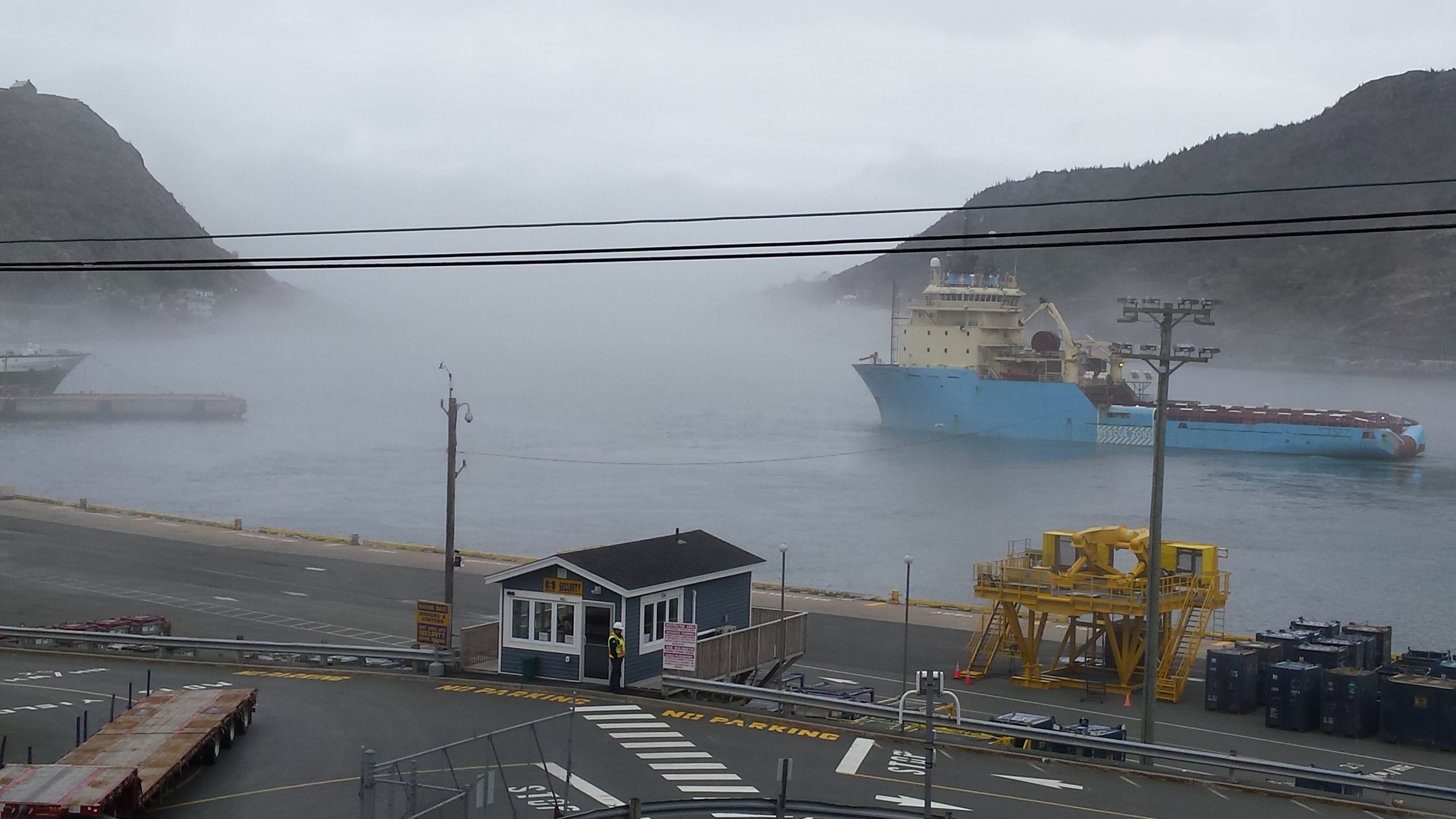
I was terrible at taking photos during the presentations, but some of the highlights were the launch of Thirteen, New Collected Poems from LGBTQI2S Writers in Canada (a League Chapbook), at The Eastern Edge Gallery, and the launch of John Barton’s latest essay anthology, We Are Not Avatars: Essays, Memoirs, Manifestos. (Windsor: Palimpsest, 2019). The Sheri-D Wilson Golden Beret Award went to Andea Thompson who slayed us with three of her Spoken Word Poems. The Pat Lowther Award was presented to Kara Du Plessis for Ekke (Palimsest Press, 2018).
The Feminine Caucus Panel moderated by Sarah De Leeuw, featured Kara Du Plessis, Andrea Thompson and Sharia Shazia Hafiz Ramji. A new Chair of the caucus, Ayesha Chatterjee, was elected to continue the initiative and work of Anne Burke.
I was not present at the Grant Writing panel, but heard good things about it, and about Edmonton’s Billy-Rae Belcourt who gave the Anne Szumigalski Lecture in a voice recitation.
Our National Council meetings (the representatives of Canada’s regions, and the Executive Committee) were lively and productive. A great Thank You to Michael Andrews, our new Treasurer, for coming to St. John’s and for having the answers on finance, and also to Lesley Fletcher, Nicole Brewer and Madison Stoner for your organizational skills, and for being there so we could know your faces and friendly efficient personalities.
An unexpected delight was Mary Dalton. Poet Laureate of St. John’s, who joined us for several presentations, and at the Ship Pub after John Barton’s launch. Spending time with her was a highlight.
Of course, we didn’t end the conference there either, for several of us went out to spot whales and puffins, rented cars and drove around the island hunting icebergs and exploring some enchanting villages. The magic of Cape Spear. I think I know at least one person in love with Brigus and its tiny library.

I’ve not said anything about other hunts, like for the World Award Winning products of breweries and distilleries of the island. Oh yes, oysters, and mussels, and carousing on George Street, during which one of our number sang on stage in a bar with accompaniment.
On our trip around a peninsula, and the western shore of Trinity Bay, I kept calling Old Perlican, Old Pelican. So much for teaching reading for forty years.

For me, a treasure was spending an afternoon at the home of Nick Avis with Tom Dawe who has been named to The Order of Canada. I had met him when we had our Haiku Canada Weekend in St. John’s a few years back. He has been the Poet Laureate of that City and has taught literature at Memorial University for many years. Tom writes haiku as well as lyric poetry and one of my prizes is a copy he signed for me of his latest publication, New and Collected poems: Tom Dawe, (2019, Breakwater Books). I could spend months listening to his voice and discussing all manner of things in the universe.
My last hours were at The Rooms, the city’s magnificent Library and Archives, where I had lunch with poets Gwen Brooker and Maureen Dunne, who gave me two of their writing group’s anthologies, and whom I enjoyed very much.
Yes, I did tuck some Iceberg Gin into my suitcase. Who could resist?






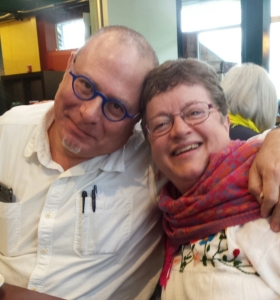







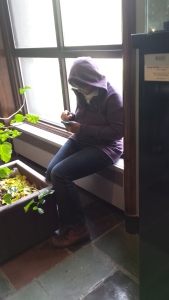
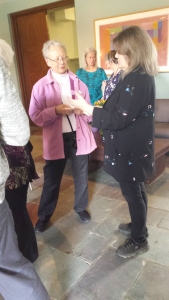


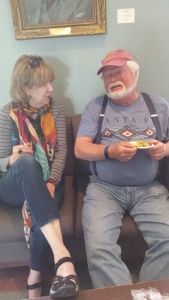
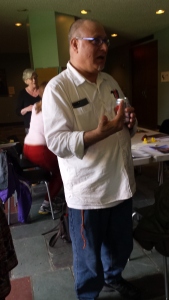


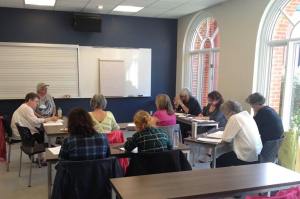
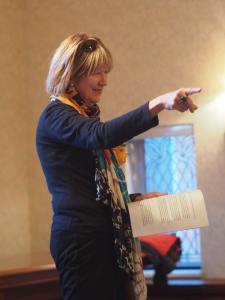


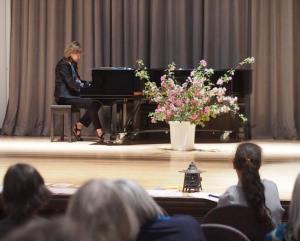


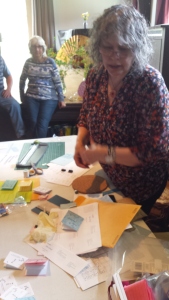


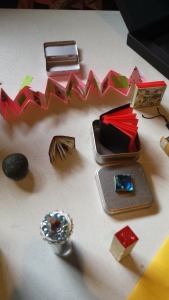
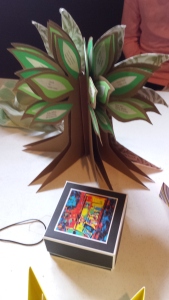
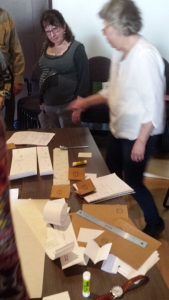

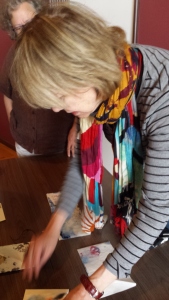


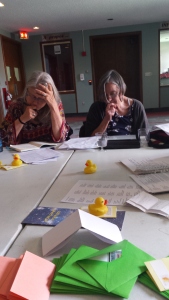

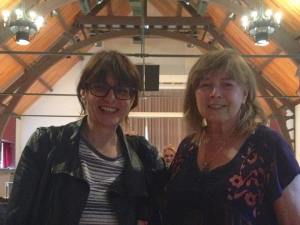
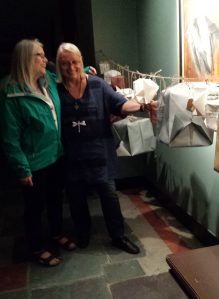 Suzanne Doereg and Lynne admire lanterns.
Suzanne Doereg and Lynne admire lanterns.









 She also completed another mystery novel, Adventures of Talking Stick, featuring her fictional protagonist Markus Fanger. She excitedly shared her whiteboard outline of the novel with me during a Skype tour of her new home built with her husband, Mike Simon.
She also completed another mystery novel, Adventures of Talking Stick, featuring her fictional protagonist Markus Fanger. She excitedly shared her whiteboard outline of the novel with me during a Skype tour of her new home built with her husband, Mike Simon.




